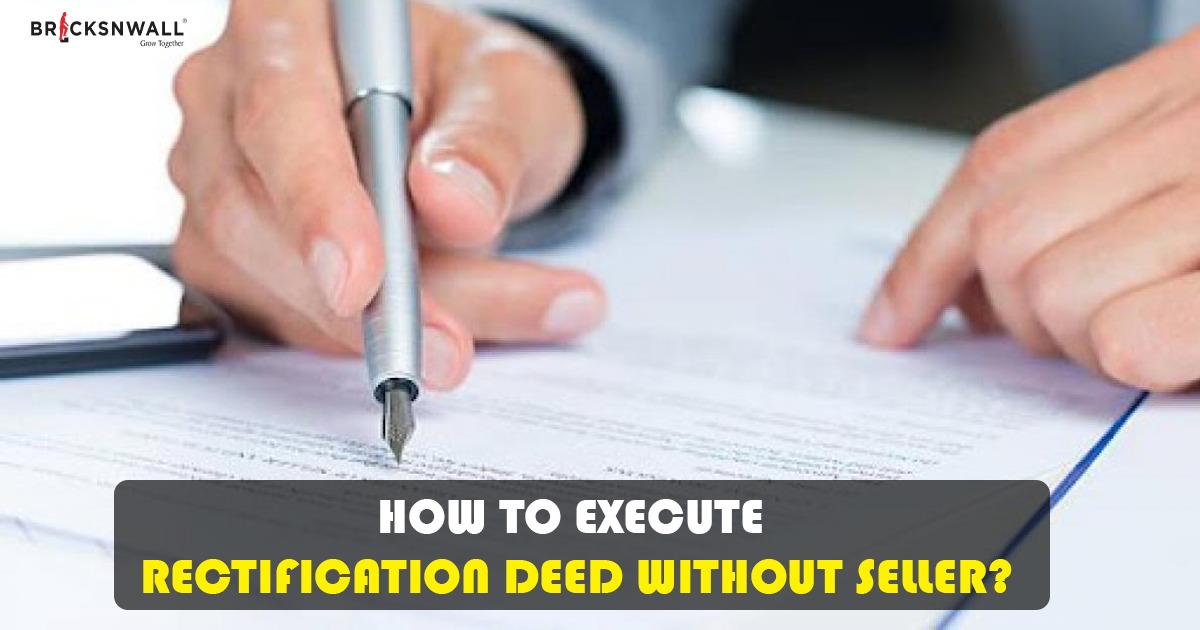How to execute rectification deed without seller?
Bricksnwall Trusted Experts

During property transactions, paperwork is
essential. However, tiny flaws such as misspelled names, erroneous area
measurements, or typographical errors in survey numbers might jeopardise the
legal validity of your documents. To quickly correct these problems, you'll
need a rectification deed—a supplementary document that nullifies inaccuracies
and ensures accurate property records.
A Rectification Deed, also known as a Correction
Deed, is referenced in Section 17 of the Indian Registration Act of 1908. A
rectification deed allows you to correct documentation problems in an existing
sale deed, transfer deed, or other property-related papers. A revision deed
allows you to add critical information or remove irrelevant property details.
However, the modification of the sale document cannot alter the nature of the
transaction or the parties' initial purpose.
Having the proper sale deed information is critical
for proving ownership of your property. Read on to learn more about how to
correct these problems.
What is a Rectification Deed?
Property acquisition agreements contain a lot of
important information. As a result, you must quickly fix any minor differences
in these details, such as spelling or numerical errors. The process involves
drafting a rectification deed. Aside from typographical errors, the sale deed
may be corrected by adding crucial information or removing extraneous elements.
Furthermore, any corrections to the registered sale
deed must be made in the presence of both parties. We refer to both parties as
the buyer and seller. If the prior owner has passed away, you can seek
rectification from the previous owner's legal heir. But what if you cannot find
a legitimate heir? In some instances, it is feasible to get a correction
document without a seller. You can request a correction with further
documentation.
What you should know about the Rectification Deed
Here are some components of the rectification
document to bear in mind.
- The inaccuracy in the original document must
be genuine and not caused on purpose. Furthermore, the error must be
factual rather than legal in nature.
- If the original deed had already registered,
the rectification deed must also be recorded.
- Everyone who was involved in the original
transaction must help get the correction deed registered.
- Parties that do not wish to proceed with a
rectification deed may seek assistance under Section 26 of the Specific
Relief Act of 1963.
- You cannot modify the sale deed unless the seller is present and signs it. If he refuses to make this modification,You will need to start the legal process.
What types of mistakes can be corrected using a
Rectification Deed?
The inaccuracy should be very clearly indicated
when applying for a repaired property document.
The rectification deed allows you to correct errors
in the property paperwork.
Here's how to approach a Rectification Deed.
- The inaccuracy should be very clearly
indicated when applying for a repaired property document.
- You can only fix or cancel minor factual
inaccuracies in your correction deed.
- This deed cannot be used to correct legal
faults.
- A correction deed is only valid when the error is real and accidental. Furthermore, all parties must agree on the corrected act.
Conditions of a Rectification Deed in India
A rectification deed is a legal document that
corrects flaws in an original property document, like a sale or gift deed. The
conditions for a rectification deed in India are the following:
Both parties involved in the original document must
agree on the corrections.
The original document's errors must be small.
The correction deed must be executed on a
non-judicial stamp paper of sufficient value.
The correction deed must be registered with the
competent authority under the same jurisdiction as the original document.
If one side does not agree to the corrections, the case can be taken to court for settlement. However, the process can be time-consuming and costly. It is always preferable to resolve such problems amicably, through negotiation and mediation.
What is the time restriction for carrying out a
correction deed?
According to Sanjeev Chanda, a counsel at the
Meghalaya High Court, the legislation does not provide a deadline for fixing
inaccuracies or inconsistencies in documents. If any party participating in the
transaction discovers faulty information or anomalies in the title document,
they must tell the other party and correct the error by executing a
rectification deed.
Given that these documents serve as proof of your
ownership of an asset, any inaccuracies should be corrected as soon as
possible. Failure to correct these issues may jeopardise your position as the
owner.
Any rectification of the sale deed must follow a
format that should include all important facts, including the inaccuracy.
The deed of correction format must provide the
following details:
The deed must include the following details:
Personal information of the relevant parties.
Details about the original deed
To correct the difference, the parties involved
must make an undertaking declaring that the original format and nature of the
transaction have not changed.
A Sample Format for Deed of Rectification
This rectification deed is made at _____________,
on _____________, between ______________, son/daughter of ____________,
residing at ______________, hereinafter referred to as the Rectifier/Vendor,
which term includes its successors and assigns of the one part.
WHEREFORE, the rectifier sold the property in favour
of the purchaser hereunder in a sale deed dated and recorded as Document No. of
Book1 volume in the file of the Sub Registrar of __________, hereinafter
referred to as the principal deed.
WHEREFORE, in the principal deed dated ________, on
line _______ of page number ________, the purchaser's name was incorrectly
entered as _______ rather than ______.
WHEREFORE, the aforementioned purchaser became
aware of this typographical issue and requested that the rectifier/vendor
correct it.
THE DEED OF RECTIFICATION IS WITNESSED AS FOLLOWS:
That is the Principal document dated _______. On
line _________ of page No. ________, the name of the purchaser of the property
MENTIONED is incorrectly recorded as __________ and is corrected as
______________ by this rectification document.
This rectification deed indicates that, except for
the aforementioned alteration, the principal sale deed is still in full force
and effect.
The rectifier/vendor has received no consideration
for the performance of this Rectification deed.
Name of the purchaser
(In the principal deed).
_________
Name of the purchaser
(As evidenced by this rectification act.)
___________
The property market value is Rs _________.
In witness thereof, the RECTIFIER/VENDOR and the
PURCHASER have set their hands on the day and month year first above written in
the presence of:
WITNESS
__________________
RECTIFIER
________________
PURCHASER
___________________
You can use this corrected deed format. It's simple
to use and may be employed in a variety of situations.
Rectification of Deed Stamp Duty
For affected parties, the rectification deed stamp
duty is determined by whether or not the original sale deed was registered. If
the prior deed is not registered, it might be nullified and a new one created.
For registered deeds, stamp duty is Rs 100.
However, if there is an error in the original document relating an area change,
stamp duty will differ, as would the rectification cost.
How Do I Use a Rectification Deed to Change My
Name?
One of the most typical purposes for a deed of
correction is to modify the name on a property document. Here's how to utilise
a deed of rectification for a name change:
Fill out the rectification deed with the right
information, including the new name that will be used on the property document.
The deed of rectification must be signed by both
parties to the original instrument.
The rectification deed must be executed on
non-judicial stamp paper of appropriate value.
Create a Rectification Deed Online
You can now arrange appointments, fill out
rectification deed stamp duty forms, and pay them online. Each state has an
official website for managing the rectification deed procedure online. Visit
the relevant state website and apply for a corrected deed.
Here are the official websites of certain states:
West Bengal: www.wbregistration.gov.in,
Maharashtra: gras.mahakosh.gov.in/igr/, Bihar:
http://bhumijankari.bihar.gov.in, Gujarat: https://services.india.gov.in,
Delhi: http://revenue.delhi.gov.in,for Karnataka:
https://kaverionline.karnataka.gov.in and Tamil Nadu: https://tnreginet.gov.in
Procedure for Rectification Deeds
Once a mistake has been detected, all parties must
be aware of it and openly agree to correct it. All parties should be present at
the Sub-registrar's office when the corrected deed is prepared and registered.
You must apply for it and submit all supporting
documentation. Any significant modification, such as a change in property
location, should be witnessed by both parties.
A Rectification Deed allows you to swiftly correct
any small errors in your property documentation. However, the majority of us
are not well-versed in many legal concepts and ramifications.
Limitations of the Rectification Deed
- Cannot be used to change legal characteristics
of documents, such as the nature of the transaction or the initial purpose
of the parties involved.
- Errors under the jurisdiction of the
Sub-Registrar's office
- A full change in the property location, which
therefore changes the jurisdiction.
- Correction Deed stamp duty errors
- The modifications require the approval of each party to the original deed. This is usually accomplished by having them sign a document acknowledging that the modifications have been made.
- One document that can be used to fix errors in property records is a rectification deed. You can carry out a correction deed by doing the following: 1. Seek legal counsel: Recognise the deed's requirements and consequences. 2. Write the deed: Make sure the corrections are legally sound and clearly identify them. Any supporting 3. documentation and the accurate information that has to be amended should be included in the deed. 4. Obtain agreement: Make sure that everyone who is affected by the deed approves of the changes. 4. Witness and notarize: To ensure the authenticity of the deed, have it witnessed and notarized. If there are significant alterations, such moving the location of the property, both parties may need to provide testimony. 5. Record the deed: To correct it, file the deed with the relevant registrar.. The original deed was registered in the sub-registrar's office, where you can schedule an appointment. An application and any other supporting documentation can also be required. The error determines the stamp duty and registration fees.
- What is the price of a rectification deed? A minimal fee of Rs 100 is charged for the registration of a correction deed in cases where the original documents only contain little errors. Higher stamp duty may be required by the sub-registrar's office if significant adjustments are required.
- The buyer may contemplate pursuing a declaratory suit under Section 26 of the Specific Relief Act, 1963, if the seller refuses to sign a rectification deed correcting mistakes in the survey number and measures specified in the registered sale deed.




